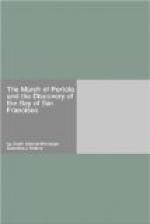Before relating the story of Portola’s march, let us consider for a moment the situation of California in its relation to Spain and other European nations, and we will then understand why Spain found it necessary to occupy the country.
When Legaspi completed the conquest of the Philippines in 1565, he sent his flagship, the San Pedro, back to New Spain under command of his grandson, Felipe Salcedo, with orders to survey and chart a practicable route for ships returning from the Islands. The San Pedro sailed from Cebu, June 1, 1565, and took her course east-northeast to the Ladrones, thence northward to latitude thirty-eight, thence sailing eastward, following the Kuroshiwo, the Black Current of Japan, they made a landfall on the coast of California about the latitude of Cape Mendocino. A sail of two thousand five hundred miles down the coasts of California and New Spain brought the voyagers to the port of Acapulco. This route was charted by the priests on board the San Pedro, and for nearly three centuries was the one followed by the galleons of Spain sailing from Manila to Acapulco. The voyage across the Pacific was a long one and ships in distress were obliged to put about and make for Japan. A harbor on the coast of California in which ships could find shelter and repair damages was greatly desired. A survey of the unknown coasts of the South Sea, as it was called, was ordered, and it was also suggested that the explorations be extended beyond the forty-second degree of north latitude, it being held that the coast was a part of the same continent as that of China, or only separated therefrom by the narrow strait of Anian, which was believed to open in latitude forty-two.
Up to this time the only exploration of the northern coast of California was that of Juan Rodrigues Cabrillo, and continued after his death by his chief pilot, Bartolome Ferrelo, in 1542-1543. Cabrillo sailed as far north as Fort Ross, anchored in the Gulf of the Farallones, off the entrance to the Golden Gate, and then sought refuge from the terrible storms in San Miguel Island, Santa Barbara Channel, where he died. Ferrelo took command and sailed up to Cape Mendocino, which he named in honor of Don Antonio de Mendoza, first viceroy of New Spain.
On the 17th of June, 1579, Francis Drake, in command of the Golden Hinde, took refuge in the bay under Point Reyes, now known as Drake’s Bay. He took possession of the country in the name of Queen Elizabeth, and named it New Albion, because of the white cliffs which, Chaplain Fletcher writes, “lie towards the sea,” and also “that it might have some affinity with our own country.” It was in this place and at this time that the first English service was held in America, by Master Francis Fletcher, chaplain to Francis Drake. The “Prayer Book Cross” in Golden Gate Park, San Francisco, commemorates the event.
Drake remained in this bay thirty-seven days, refitted his ship, supplied himself with wood and water, and sailed on July 23d to the Southeast Farallones, where he laid in a store of seal meat, and on the 25th sailed across the Pacific for England by way of the Cape of Good Hope.




